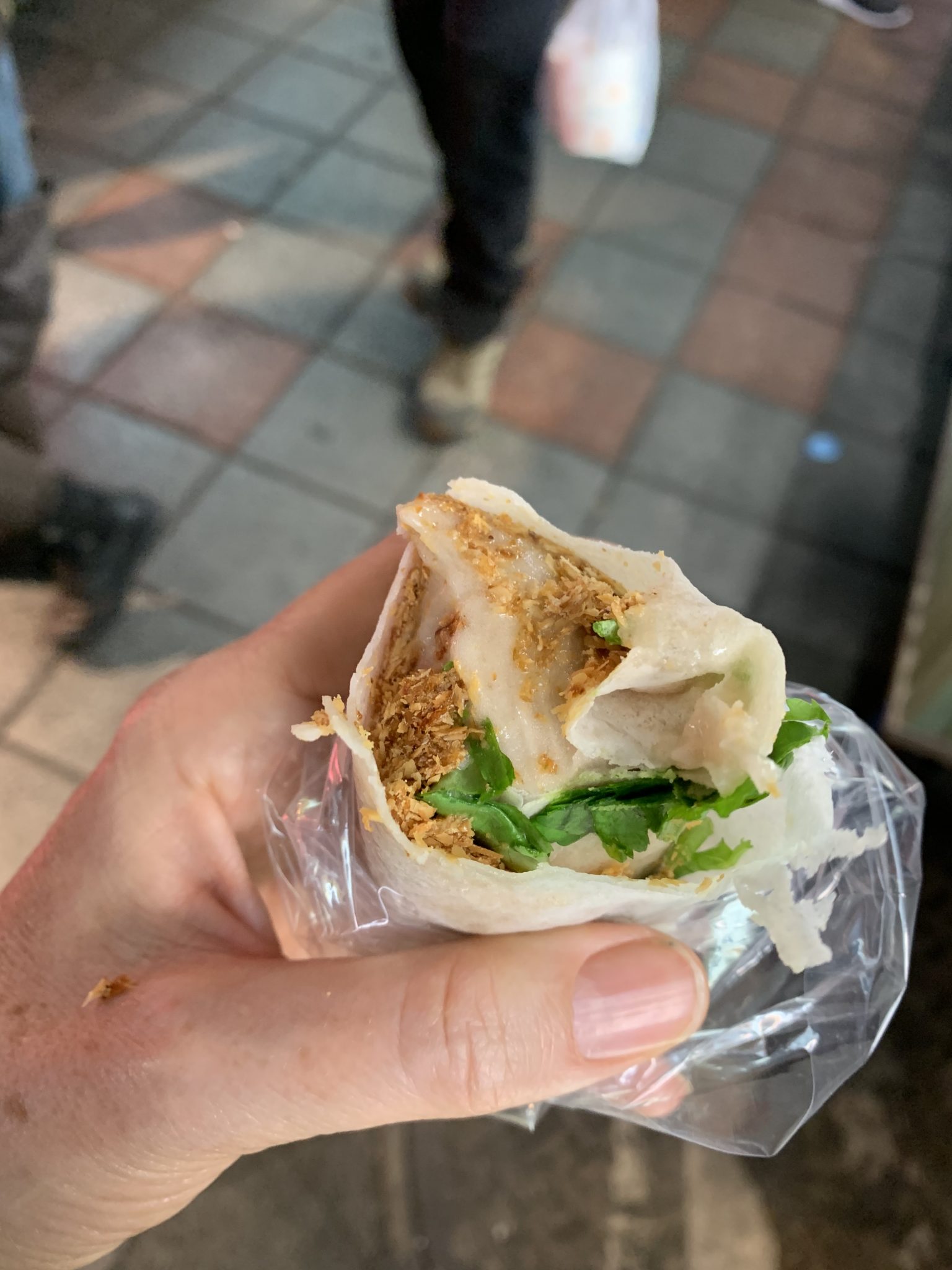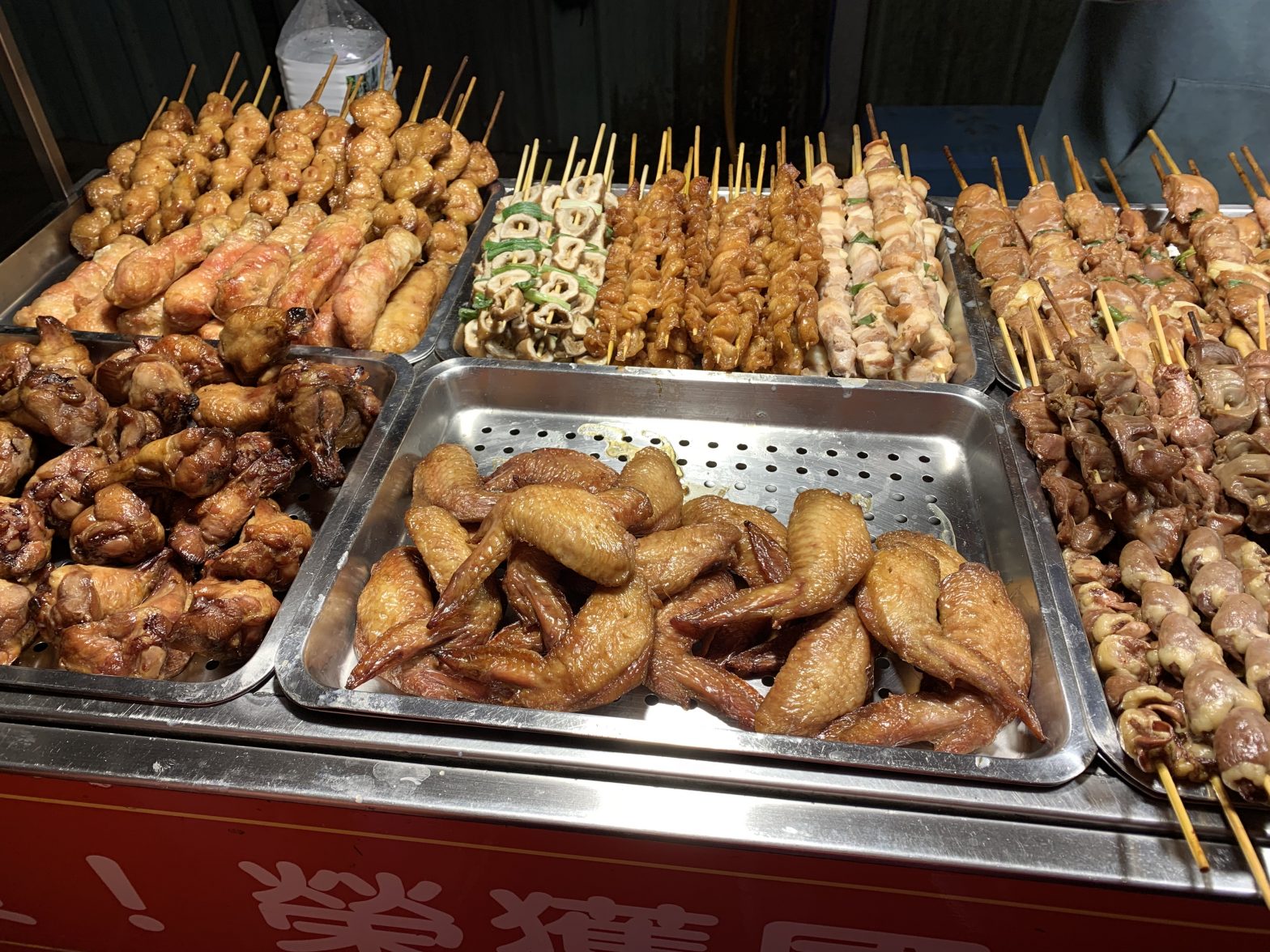When you tell anyone in SE Asia that you’re going to Taiwan, they roll their eyes ecstatically and say, ‘Ooh – the food!’
So when I arrived in Taipei, getting to grips with the local food was my number one priority.
I really like walking food tours, where the tour guide walks you around an area of the city and talks about the history, the culture and the food – and takes you to some great eateries. It then gives you enough of an understanding to be able to strike out on your own afterwards.
Taiwan is all about street food, so I booked a night market food tour, where my guide, Joanna –

took me around the stalls and explained what everything was. She then let me try whatever I fancied, with a few recommendations thrown in.
These baked pork dumplings were delicious –

The stallholder makes about a million a day, I should think, and as they only serve one thing, they’re pretty good at making it.

I didn’t try the duck head –

– I didn’t think it would be very substantial.

Then we moved on to the intestines in the picture below, and the ones on the left, wrapped up like a pair of earphones, were quite nice. These are the small intestines – the large intestines are on the right, stuffed with spring onions which makes them look like wrinkled brown carrots.

This is pigs’ blood on a stick –

I was dubious at first, but actually liked it when I tried it.
And this is a pancake filled with vanilla ice cream, crushed peanuts … and fresh coriander –

No, I wasn’t sure about the coriander, either – but somehow it works!
One useful tip I was given – if you see a long queue at a stall, join it, because whatever they’re selling is going to be good.
There was a huge queue at this stall for their fried taro balls, which were hot and crispy on the outside and fluffy in the middle.

I’m now a confirmed taro fan.
These strange-looking things are fresh water-chestnuts –

– that the stallholder is painstakingly peeling one by one. I’d never seen a fresh one before, only the tinned ones that were the height of adventurous eating in England in the 1970s.
Then I tried a steamed bun stuffed with pork and pickled vegetables, which was divine.

I realised that I’d gone from a pork-free country to a pork-obsessed one, and Joanna told me that Taiwanese pork is highly prized because they castrate the male pigs, which makes them taste better. So I shall be passing this advice on to any pig farmers I meet in the future.
Last stop was shaved ice with different toppings –

but it wasn’t nearly as good as Malaysian cendol.
Emboldened by my experience, I signed up for another food tour – this time at a very local night market – where I got to try the most famous Taiwanese dish … stinky tofu. They’re very proud of it, in much the same way as Malaysians are proud of their stinky speciality, durian.
I learnt that there are three levels of stinkiness, according to the way it’s cooked:
Level 1, or entry level, is fried
Level 2, or GCSE level, is barbecued
Level 3, definitely PhD level, is boiled.
I tried Level 1 – served with kimchi –

and then skipped straight to Level 3 – served in a bowl of broth with a large portion of duck blood, which is the liver-like lump just being put into the bowl in this picture –

Unlike pigs’ blood, which is chewy and savoury, duck blood is gelatinous and slimy, and was the one thing I didn’t enjoy eating on the food tours.

Stinky tofu is pungent and lingering, and is often compared to blue cheese. So, if you like a bit of Stilton, you won’t be fazed by even Level 3 stinky tofu.
Now that I was becoming a pro, I branched out and tried pigs’ blood with a peanut coating –

– and then rolled intestines again – but this time served on the side with a bowl of oyster and noodle soup –

Do you know what they use to clean intestines ready to eat?
Coca-Cola is the answer.
This made me wonder two things:
- What does it do to our intestines when we drink it?
- What did they use before Coke was invented?
Here are some octopus balls –

crunchy and chewy and served with mayonnaise and some flaky stuff that looked like onion skin, but tasted of nothing.
And a chicken foot – no bones, just the cartilage –

a bit gristly for me, but a very popular snack for the locals.
And finally, just to reinforce a point I made earlier, here’s one of the two most popular exhibits in the National Palace Museum –

It’s a piece of banded jasper, lovingly crafted to look just like a piece of pork.

I think the British Museum should take note, and commission a stone shaped like a Yorkshire pudding, a Cornish pasty or – for a touch of colour – a slice of Battenberg cake.
